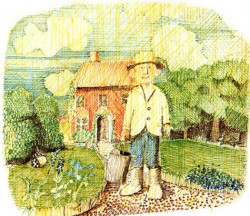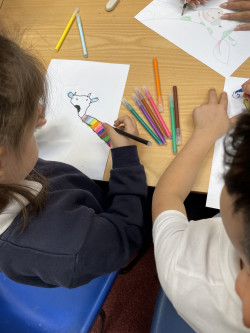May 17th, 2021
A-Z of ArtistsKathrin Rohmann and Apple Cake and Baklava
A quarter of our autumn theatre programme celebrates international authors and illustrators and we have always been passionate about bringing the very best artists from around the world to the attention of teachers and children in the UK.
This year is no different, and to celebrate the letter K in our A-Z we are focusing on the German author Kathrin Rohmann and her book Apple Cake and Baklava. Kathrin will be on stage with her translator Ruth Ahmedzai Kemp at The Stables in Milton Keynes on Friday 5th November at 11am. Find out how to book tickets here!
We are often asked how we choose the artists who take part in our tour, and both Kathrin and her beautiful book demonstrate that it's simply that we always seek excellence! It explores difficult ‘issues’ but through the characters and their relationship with one another. The story comes first. It is beautifully written, humorous and moving, and most importantly it shows us that even after great loss it is possible to begin again.
Book of the Week: Apple Cake and Baklava
written by Kathrin Rohmann, translated by Ruth Ahmedzai Kemp

Leila is the new girl in Max’s class in rural Germany, and they soon become close friends. She has fled Syria with her family, having left her beloved grandmother and father behind. Her most cherished object is a walnut from her grandmother’s garden. Leila is desperately sad when she loses her beloved walnut and, in a failed attempt, sets out to return to Syria.
“Apple Cake and Baklava sensitively depicts the heartache of a youngster desperately missing her beloved grandmother and her home... this book deserves to be in primary schools throughout the UK and, indeed, the rest of Europe. It could hardly be more timely, or more urgent.”
European Literature Network
Read the first two chapters of the book here
Author in focus

As a child Kathrin Rohmann loved stories by Astrid Lindgren, and when she was 14 she told a friend that she too would write books for children one day. Kathrin grew up in a small flat with only a bird in a cage, but she loved animals and so she took an apprenticeship on a farm. She learnt to milk cows, feed pigs, drive a tractor and mow pastures! Later, she studied to become an agricultural engineer. Apple Cake and Baklava is her second book and a special one. It draws on Kathrin’s family roots in Pomerania and the stories of her great grandparents as well as the situation that unfolded in 2015 when thousands of Syrian people took refuge in Europe. With help from the “Akademie für Kindermedien” it became a wonderful story of losing and finding, of longing and hoping, of friendship and arriving.
Activities!
Visualise the Setting
In the story, Kathrin Rohmann’s evocative descriptions create strong visual images in the reader’s mind. Choose one of the scenes from the story and draw it. You could use pencil crayons, pastels, paint, collage or you could just use pencil and emulate the beautiful illustrations by Franziska Harvey.
Scene 1
He sips his cocoa while looking out of the window. Their tabby cat scampers across the yard in front of the large barn, a mouse dangling from her mouth. The cobblestones glisten with the rain that fell in the night. The wind had swept a heap of yellow sycamore leaves between the harrow and the old trailers parked under the canopy.
Scene 2
The morning light falls into the workshop through the open door. It’s quiet in here. On the right is the old workbench, which was probably used by Max’s great-great-grandfather. There are spanners, inner tubes, a packet of small light bulbs and countless screws. Next to the workbench, tidily arranged, stands Max’s bike collection: a brand-new mountain bike, which hasn’t got a saddle yet, an old black bike with gold writing on the frame that is peeling off, a road bike, a silver ladies’ bike and a blue men’s bike with a bent handlebar, a really big front lamp and a basket on the bag rack.
Scene 3
Her bed is in a small, narrow loft room with a sloped ceiling. There is a colourful rug beside the bed. A few pieces of furniture huddle together awkwardly, like strangers. They don’t really go together. An old kitchen table as a desk, a chest of drawers painted bright green, a chair and a pale, flowery armchair, with the clothes Leila will wear today neatly folded on it. A few of Leila’s drawings are fixed with pins to the wall above the chest of drawers.
One picture is of the Syrian flag, one is of a large tree in a lush garden, one is of a bakery, one is of someone in a bed, in what looks like a hospital, and one has just a tiny dark spot in the middle of an entire sheet filled with blue.
A pale yellow curtain hangs in front of the window, though it is too thin to keep out the gloomy morning light of a damp November.
Leila and Max Make Friends
In the extract Leila and Max have not yet spoken to one another. However, if we look at the front cover, and read the blurb of the book, it is evident that they form a firm friendship.

Leila is the new girl in Max’s class in rural Germany, and they soon become close friends. She has fled Syria with her family, having left her grandmother and father behind. Her most cherished object is a walnut from her grandmother’s garden. Leila is desperately sad when she loses her walnut and, in a failed attempt, sets out to return to Syria.
Write a new chapter for the story in which Leila and Max meet. Think about how they meet, what they might say to one another and how they become friends. Alternatively, draw a cartoon strip, or create one using a digital comic creator such as https://www.storyboardthat.com/storyboard-creator.

Explore Leila and Max’s World
We can tell from the extract that Leila is originally from Syria and is seeking refuge with her mother and two brothers in Germany, in a rural village near the city of Hanover. Leila fears that her father and Grandma are still in Damascus, which is the capital city of Syria. We also learn that she travelled on a boat from Lebanon and that she has lived in Friedland, perhaps when she first came to Germany.
Use Google Earth to explore the different places referred to in the story: Hanover, Friedland, Lebanon, Syria and Damascus. Zoom into the map to see how different the landscapes are in each of the countries.
As you travel virtually from one place to another, try to get a sense of the vast distance which Leila has travelled and imagine how she must have felt, leaving her home behind and travelling all that way to a new country, and a new life.
Apple Cake and Baklava is a work of fiction, yet Leila’s experience is very real for millions of refugees across the world. You can find out more about refugees by visiting the Save The Children website.





